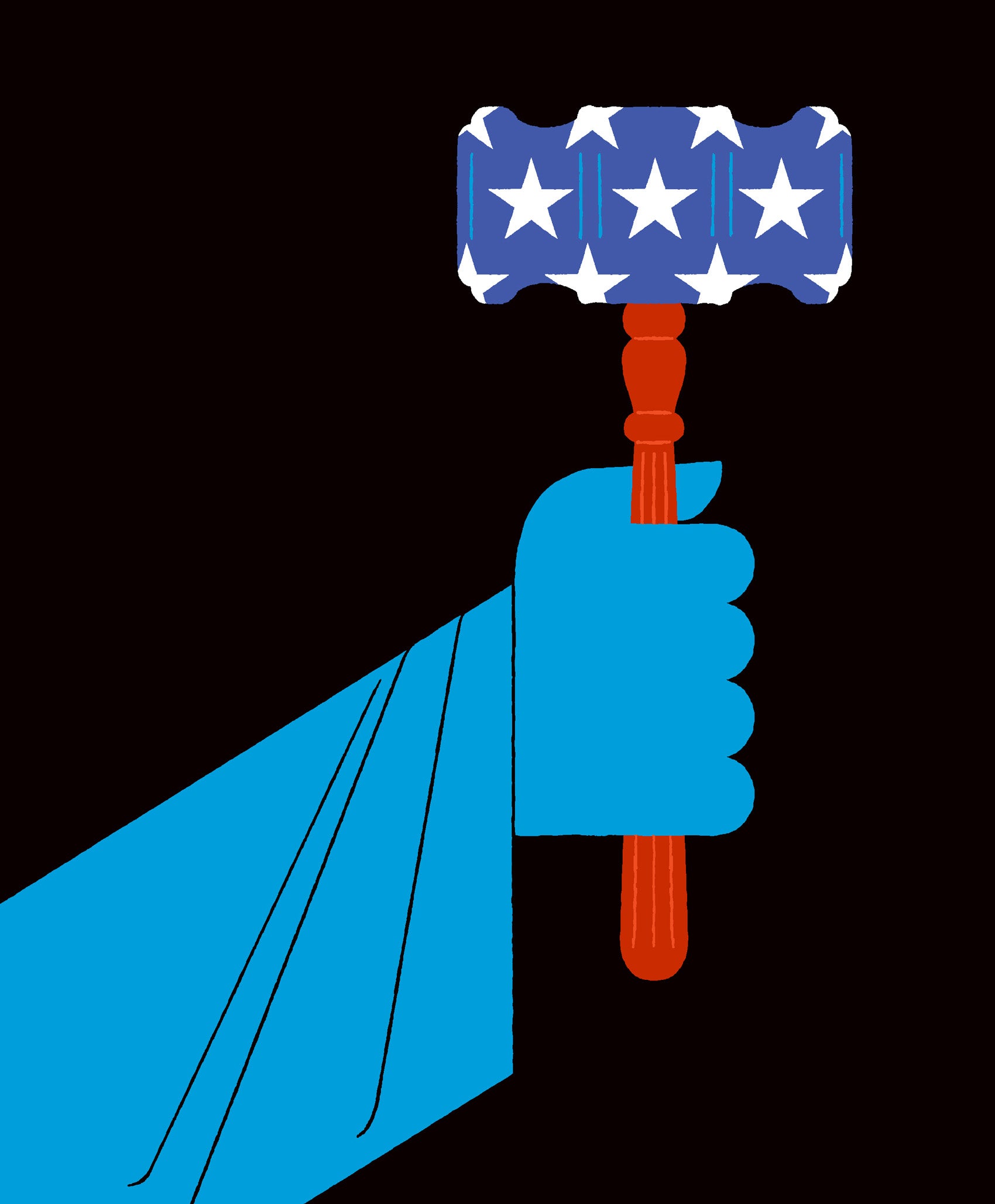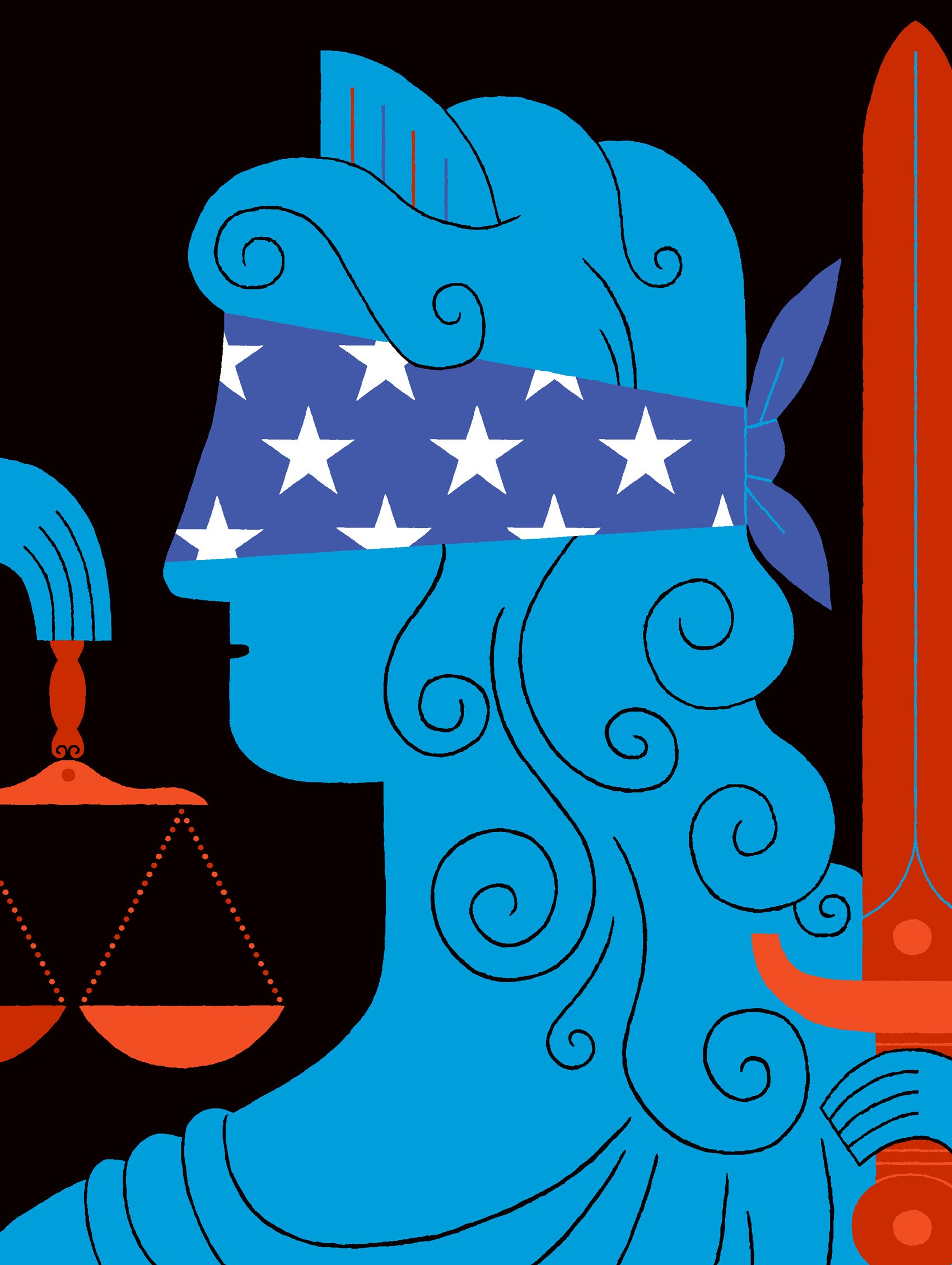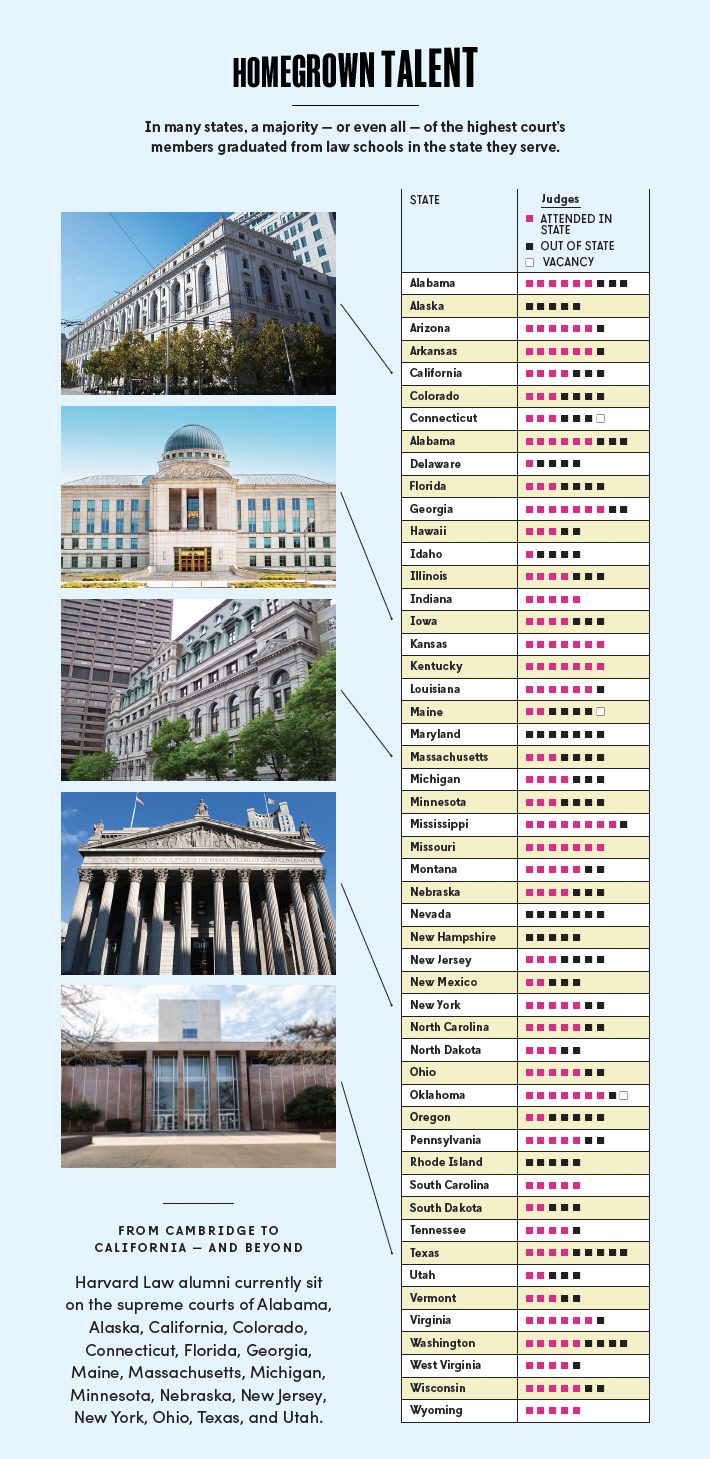Quick: Name the five to nine members of your state’s supreme court. Perhaps you can rattle off every one of your esteemed justices. Maybe you know one or two. But if you’re like a lot of Americans — and maybe even most lawyers — you may have only a fuzzy idea of who sits on the highest court of, say, Massachusetts or Kentucky or South Dakota, let alone how they got there and what they do.
The centrality of state law is reflected in the number of cases in state versus federal courts: In 2023, 67.5 million compared with 920,000
That could be a mistake. In recent years, the United States Supreme Court has issued decisions that leave for state legislatures and courts crucial choices related to hot-button topics such as abortion, the environment, gun control, voting rights, and more.
Yet some experts insist that this is not a new phenomenon. Instead, they argue, states — and by extension, their courts — have long wielded power over matters central to our everyday lives, from marriage and adoption, to our education and jobs, to our health and safety, and beyond. And it is in our 50 state supreme courts, and the District of Columbia’s highest court, that laws about these things are tried and tested, shaping the future of our rights, responsibilities, and freedoms.
Do these factors point to a renaissance in our federalist system — and if so, could its benefits be enjoyed by those on both sides of the political divide? And with state supreme courts acting as the final arbiters of state law, is it time to start paying them more attention?
A Renaissance of State Law
Consider your typical Monday morning. Perhaps you turned on your bedside lamp before pouring a glass of water (public utilities law) and eating a bowl of cereal with milk (food law). Maybe you said goodbye to your spouse (family law) before driving your child to school (education law, traffic law) and heading in to work (employment law) in an office park (zoning law). It’s not even 9 a.m., and already your day has been shaped by a spate of state and local laws.
That’s been the case since the nation’s origins, says Jeffrey S. Sutton, chief judge of the United States Court of Appeals for the 6th Circuit and a lecturer on law at Harvard. “Barring a war, most of the things you do in a week are affected most directly by your state or local government,” he says.

With state supreme courts acting as the final arbiters of state law, is it time to start paying them more attention?
The centrality of state law is reflected in the number of cases in state versus federal courts: in 2023, 67.5 million compared with 920,000, according to the National Center for State Courts. Yet Sutton says that scholars and the national media, until recently, have not always recognized this.

“If you looked at the whole history of The New York Times and The Wall Street Journal, I’ll bet they have written more articles about state courts and state constitutions in the last five years than they’ve written in their entire 100-plus-year histories,” he says.
Molly Brady, the Louis D. Brandeis Professor of Law at Harvard, surmises that political and social changes help explain why the public’s focus turned to federal law by the mid-20th century. She says that the growth of the national government, coupled with groundbreaking U.S. Supreme Court cases upholding key parts of the New Deal, desegregation, and civil rights, solidified federal authority in new domains. These developments in turn influenced law schools and legal pedagogy, further reinforcing the prominence of the national judiciary.
But the tide seems to be turning. Perhaps the most well-known and controversial example of this phenomenon is the U.S. Supreme Court’s opinion in Dobbs v. Jackson Women’s Health Organization, a 2022 decision that overturned Roe v. Wade’s recognition of federal constitutional limits on abortion regulation and thus leaves the issue to the states.
Sutton sees Dobbs, along with Rucho v. Common Cause (2019), in which the Court held that questions of partisan gerrymandering are beyond the reach of federal courts, as major decisions that moved authority, and media and academic focus, to state law.
“In both cases, the Court overrules a prior decision, and in both cases, instead of occupying the field, it withdraws and allows our state legislatures, courts, governors, and the people to try their own approaches to these things,” he says. “It’s really dynamic.”

For Sutton, this is less of a departure from the norm than a return to the country’s roots.
“What’s funny is that we have really embraced the federal U.S. Constitution, but we’ve forgotten where it all came from,” he says. “At the Philadelphia Convention in 1787, when they were drafting the original U.S. Constitution, the key ideas came straight from the state constitutions, and the same was later true when they drafted the first eight provisions of the Bill of Rights.”
Brady, an expert in property and land use law, agrees that state courts have always been significant. Federal courts are courts of limited jurisdiction, she points out, meaning they overwhelmingly are limited to resolving questions of federal statutory and constitutional law.
“The bulk of what we think of as ‘law’ is done in the states,” she continues. “There’s more interest now than there has been for some decades, and I think that’s a great thing.”
Not everyone is satisfied with the new status quo, she acknowledges. “The downside to federalism, of course, is if you have a very strong, substantive view about what is correct, you want it to apply as broadly as possible.”
Justice Melissa Hart ’95, who has served on the Colorado Supreme Court since 2017, says there are some issues where local solutions might be unjust or inadequate.
“Sometimes, we have seen a diminishment of people’s rights that can come with not recognizing certain national standards,” she says. “Or consider the challenges of regulating the internet or social media, as another example. We are in a world where the geographic boundaries that made sense before the internet don’t make as much sense anymore.”

A national approach also makes sense when there is a broad consensus around an issue or when a federal solution is needed to protect civil rights, Sutton says.
“The Supreme Court brought Jim Crow to heel in Brown v. Board of Education,” he says. “And then, in case there was any doubt, Congress in the 1964 Civil Rights Act nationalized the idea that we weren’t going to allow segregation based on race or discrimination based on sex, and so on.”
But on many other kinds of issues, local control is uncontroversial, Sutton says. “No one protests the fact that we have 51 tax systems. It may be annoying to have to fill out more than one return on tax day, but most people are comfortable with different states having different priorities and raising revenue and spending it accordingly.”
Ultimately, Brady says, those who embrace the state-by-state model “take the bitter with the sweet.”
“If you accept this idea, that may mean you don’t get substantive perfection, or at least as quickly as you might like,” she says.
‘A Second Chance’
Debates about federalism date back to the country’s founding, Sutton says. From the outset, he points out, “the key question is what problems should be resolved locally and what problems should be resolved nationally.” Both sides of the political aisle, he adds, could benefit from this system of government today. “I don’t want to go out on too much of a limb, but it is possible that the majority of Californians don’t want the new administration in Washington in charge of all of their public policy.”
He compares the U.S. to a large opinionated family. “Do you really want to have to resolve every issue as a family?” Sutton asks. “It might be nice to let one person do one thing, and another person try another approach, and maybe see which one works best.”
This concept — that states are “laboratories of democracy,” a phrase famously offered in a 1932 decision by Supreme Court Justice Louis Brandeis LL.B. 1877 — posits that new ideas can be tested in one location and accepted or rejected in others as time goes on.
This is possible in part because making state law is just easier, says Justice John D. Couriel ’03 of Florida’s Supreme Court.
“The genius of our system is there is a fair degree of choice and a fair degree of experimentation by the states,” he adds. “You may really love living a certain way in Nevada that is totally different from how you’d live in New Hampshire, and that’s good. I think it makes our system more robust and resilient that it is capable of such flexibility.”
“The genius of our system is there is a fair degree of choice and a fair degree of experimentation by the states.”
Justice John D. Couriel
Perhaps even more significantly, state constitutions can offer protections beyond those prescribed in the federal Constitution, such as those touching on voting rights, education, privacy, the environment, and more. In addition to being more comprehensive, state constitutions are often simpler to amend, both by legislatures and, in some states, by citizen-led initiatives.
“State constitutions address more subjects, and probably relatedly, they’re easier to change than the U.S. Constitution,” says Jonathan J. Papik ’08, a justice on the Nebraska Supreme Court. “You can see how those two factors would be related to each other. If it’s easier to amend, the people are going to amend them more frequently, and they’re going to amend them to speak on more subjects.”
The point is, they’re formidable, Sutton says. “Let’s say the U.S. Supreme Court issues a decision refusing to recognize a constitutional right. State constitutions give you a second chance at affirming that right. And who wouldn’t want a second chance?”
As is the case with many state constitutions, Florida’s foundational document is much longer than its federal counterpart, says Couriel.
“Our constitution is probably around 40,000 words long,” he says. “The U.S. Constitution is less than 8,000. And in that imbalance, you’ve got a story about federalism, which is that our states are charged with so much of the law that matters to the daily life of each citizen. It is like putting out your thumb to block the sun, if you’re not paying attention to state constitutional law.”
The structure of state constitutions can also differ from that of the U.S. Constitution. Hart of Colorado says that her state’s constitution is unique as a “rights-first” document. “The first substantive part of our constitution is our bill of rights. Before we talk about structure of government in our constitution, we talk about the rights of the citizens.”
But Who Are They?
If states are laboratories of democracy, their supreme courts must play a leading role in the grand democratic experiment. So, who, exactly, are the members of these courts?

“ I’m troubled by the notion of being responsive to the people. I think we’re supposed to be responsive to the law.” Justice Melissa Hart
The answer, as you might expect, is complicated. Each state has its own history, culture, norms, and processes that shape the makeup of its high court and the types of cases the court can — or must — take. But there are some commonalities. For one, every state supreme court has a binding ethics code — and, unlike the U.S. Supreme Court, they all employ independent watchdogs to monitor and sanction wayward judges.
“I think it’s important to have judges who themselves are ethical and who self-examine their ethical obligations, and also to have an impartial body that can investigate and enforce when a judge falls down, as a way to encourage public trust,” says Hart. “As a neutral decision-maker in matters that are some of the most important in people’s lives, you really need to be above reproach.”
Moreover, state supreme court justices are not always appointed, as members of the U.S. Supreme Court are. In many states, voters have a hand in electing members of their high court — and in some locales, the judges even run as members of a political party.
Twenty-two states employ the Missouri Plan, or a hybrid of it, whereby candidates are nominated by a nonpartisan committee and the governor chooses from those nominees. Those justices are then subject to future retention elections. And unlike the U.S. Supreme Court, no state except for Rhode Island provides life tenure to its justices. Instead, they are subject to either normal elections or a retention vote.
Whether justices are elected, appointed, or a combination of both, there are trade-offs involved, says Brady of Harvard Law.
“It’s a bit of ‘pick your poison,’” she says. “In states where justices can be recalled, we have seen political actors try to get people kicked off on the basis of their decisions, and that does worry me. On the other hand, it’s a very democratic process.”
There are other potential downsides to the ways states select their justices. According to a recent study by the Brennan Center for Justice, state supreme courts often lack racial and gender diversity — in 19 states, for example, there are no persons of color on the high court.

But state supreme court justices may reflect other kinds of differences, such as less traditional paths to the judiciary. Couriel, the justice from Florida, was not an appellate judge before being recommended and then selected by Gov. Ron DeSantis ’05 in 2020. Instead, he started his career in mergers and acquisitions and served as a federal prosecutor specializing in international crimes.
Couriel’s hope is that, with new attention to the work of state supreme courts, the public and media will come to better understand what he and his colleagues do. Regardless of how justices are chosen, he says, the role is not political.
“Our job as judges is not to say what the law ought to be; it’s to say what the law is. Nobody elected us to say what the law ought to be,” he says. “People have retained me in my role, but not because of anything I said. I don’t mistake that for permission to say what the law ought to be.”
Similarly, Hart, who was selected from a panel of nominees by then-Colorado Gov. John Hickenlooper, emphasizes that her role is to interpret the law — not make it. “I’m troubled by the notion of being responsive to the people. I think we’re supposed to be responsive to the law,” she says. “We have an obligation to interpret what the legislators passed.”
Electricity, Marijuana, and the Law of Our Daily Lives
Just as all states have their own methods for selecting and retaining justices, they also have their own rules about what kinds of cases their highest courts must take — that is, over which cases their highest court has mandatory jurisdiction.
Many states require their supreme courts to consider election disputes, cases in which a state law has been deemed unconstitutional by a lower court, and judicial disciplinary matters. Depending on your state, your supreme court also might approve rate increases for electricity and gas (Florida) or review disputes over language used to describe critical ballot initiatives (Colorado). State justices may even be required to consider all first-degree murder appeals (Nebraska and a few others).
But state supreme courts, like their federal counterpart, also have plenty of leeway to choose cases they deem significant.
To Papik, who was appointed by then-Nebraska Gov. Pete Ricketts in 2018, a typical term involves cases that touch on nearly every aspect of people’s lives. “We have cases involving criminal law, the state constitution, family law, domestic cases, juvenile cases, and civil cases, which is everything from breach of contract to disputes to protection orders. And then we also get a fair number of workers’ compensation issues as well.”

Papik says that, unlike the U.S. Supreme Court, which generally prefers to let a significant issue percolate through the lower courts for a while before considering a case on it, his court prefers to act quickly.
“In general, our tendency is not to wait when issues of first impression arise,” he says. “We tend to take the case and settle it, so that the district courts and county courts around the state of Nebraska know what our interpretation is, and they can follow it.”
Hart in Colorado says that her court also hears a variety of cases but adds that a majority are related to criminal appeals. State courts also often interpret the U.S. Constitution in these cases, she adds. “State courts are really where the Fourth and Fifth Amendments are getting worked out.”
A unique feature of her state’s constitution — a 2012 amendment legalizing the recreational use of marijuana — makes these questions about due process and police conduct even more interesting, Hart says. “When we passed that provision, the Fourth Amendment starts to look different. Under Colorado law, a police dog who is alerting to the smell of marijuana doesn’t give the police cause to search a car.”
For Hart, the constitutional amendment is also an example of the ways in which community and culture can be reflected in state law.
“There are other examples of states grappling with challenges that truly are local challenges, and that are hard to understand if you’re not living in those local communities,” she says. “This is such a large country. There’s value to having local control and local opportunities to solve problems that are peculiarly local.”
Challenges and Opportunities in Interpretation
State supreme courts also face unique challenges and opportunities when interpreting their laws and constitutions. For one, there is much less scholarship written about state constitutions in general, notes Papik of Nebraska. There are also fewer contemporaneous sources to give a sense of what people were debating and thinking about when many constitutional provisions were written, he says.
“With the U.S. Constitution, you have the Federalist Papers, you have the debates from the Constitutional Convention,” says Papik. “You have debates when states were deciding whether to ratify. And while there are some resources available about the Nebraska Constitution, there’s not nearly as much.”
He encountered this problem recently, when his court was asked to interpret a 19th-century provision of the Nebraska Constitution. Those looking to find the provision’s original meaning were stumped, he says. “The records from the minutes of the 1875 constitutional convention were lost to a fire early on.”
On the other hand, for newer constitutional additions, there may actually exist more references for judges, notes Couriel of Florida: “It can be much easier to do originalism as a state supreme court justice. Often we are working with words whose meaning is easier to ascertain because [the sources] were drafted more recently.”
He points to a 2024 Florida constitutional amendment that guarantees residents a right to hunt and fish. “Not a word has been written on what that means,” he says, “but the original public meaning of those words will be determined with reference to 2024 sources.”
The Future with Federalism
Perhaps one of the biggest difficulties posed by our federalist system is knowing where to focus our attention, with 50 states each doing their own thing. But for Brady, that’s part of the fun.
“Without offense to Montana, I don’t think anyone saw Montana’s recent decision coming, about a state constitutional right to a healthful environment and that state legislation was violating the constitution by enabling various emitters [of pollutants],” she says. “Exciting cases could really come from anywhere. It’s just a matter of where they percolate up.”
That’s also why Brady pushes her students to consider state law as closely as they study federal law. “I tell my students to never be the lawyer that brings the federal claim and then just tacks on the state claim. It’s a separate claim, and it deserves your thought and care and attention.”
“The effect of this is going to be to push some of these very contentious issues to the state level.”
Justice Jonathan Papik
To Sutton, the judge and Harvard Law lecturer, there is new political energy brewing in the states, making it an exciting time to practice state law. “Anything that we Americans are conflicted about nationally, I can promise you, we’re conflicted about locally, and you’re going to see litigation in those areas.”
There are still reasons to be cautious, however. Hart of Colorado worries that as attention shifts to the states, partisan actors will move to make the selection of judges more political. “I think we should be worried where we see people trying to politicize state courts. I urge people who live in states with less partisan methods to stick to their guns on that.”
She also foresees more fighting about where cases are heard, whether in federal or state court. “You already see a lot of gamesmanship within litigation about which court a case is in, and so I could imagine that that could be part of litigation going forward in both political cases and more run-of-the-mill, big financial stakes litigation.”
To Papik, in Nebraska: “The effect of this is going to be to push some of these very contentious issues to the state level and state legislature, but also to state courts and state constitutions. Rather than having one federal standard, we’re seeing across the country different policy approaches from legislatures, different initiatives and measures adopted by citizens, and different conclusions reached by courts.”
And for Couriel of Florida, the future may not be predictable, exactly. But he is sure of one thing.
“I don’t think there’s been a more exciting time in the experiment,” he says. “I am very long on the United States. I believe that, despite all our struggles — and indeed, in part because of our ongoing struggles — there is no greater constitutional system in the history of human government.”

